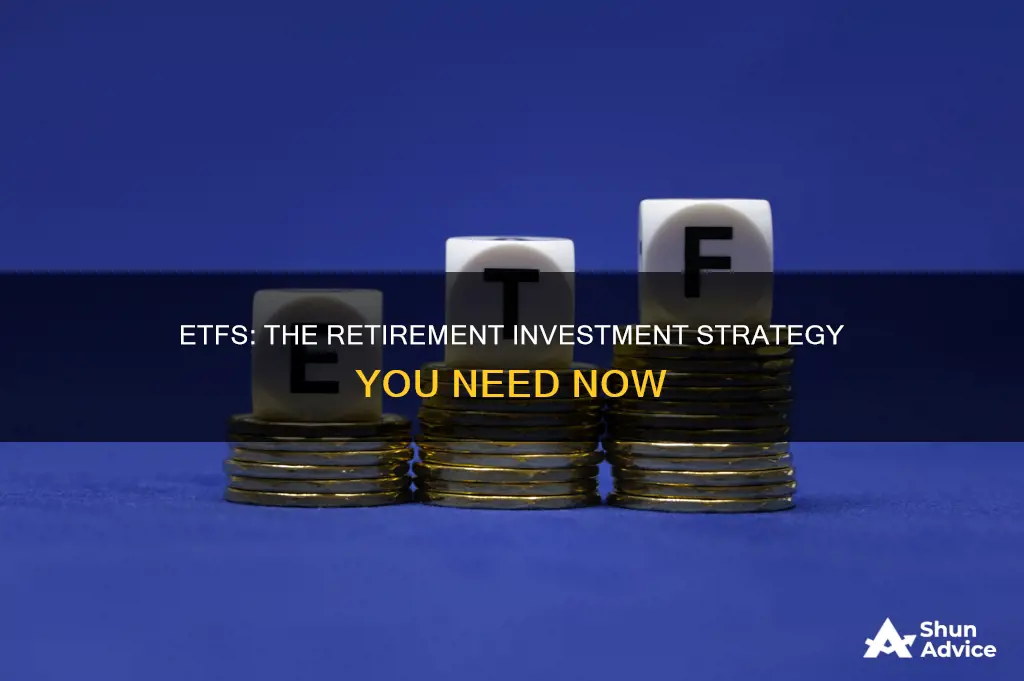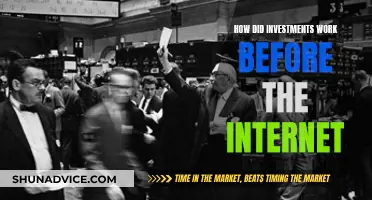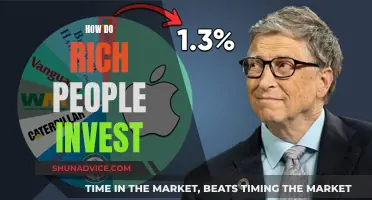
Exchange-traded funds (ETFs) are a great option for retirement investing. They are similar to mutual funds, but ETFs are traded on a stock exchange and their share prices fluctuate throughout the day. Here are some reasons why ETFs are a good choice for retirement:
1. Diversification: ETFs hold various assets, so they are naturally diversified. Diversification is critical for retirement investors because it spreads out risk and smooths out volatility. Most ETFs track financial market indexes and hold hundreds or even thousands of positions.
2. Easy to manage: It only takes a few ETFs to build a balanced portfolio. For example, you can combine ETFs that give you broad exposure to U.S. stocks and bonds, and then add in international equities for further diversification.
3. Low fees: Most ETFs have low expense ratios compared to other investment options. This is because they are passively managed, meaning there is no dedicated fund manager. As a result, operating costs are lower, and a higher portion of the fund's earnings flow through to investors.
4. Index tracking: Index ETFs are constructed to mimic the performance of an underlying index, like the S&P 500 or the Nasdaq 100. While they may not achieve exactly the same return, their performance tends to be reliable and consistent.
5. Tax efficiency: ETFs are usually more tax-efficient than mutual funds. This is because ETFs are passively managed, so assets are bought and sold less frequently. This results in lower capital gains taxes for investors.
6. Lower minimum investment: ETFs can be purchased by the share, lowering the cost of establishing a position. Mutual funds, on the other hand, often have minimum investments of $1,000 or more.
In summary, ETFs provide easy, cost-efficient access to diversification and market-level returns, making them a great option for building your retirement savings over the long term.
| Characteristics | Values |
|---|---|
| Cost | ETFs are a popular investment choice for retirement due to their low costs. |
| Tax efficiency | ETFs are considered more tax-efficient than mutual funds. |
| Diversification | ETFs can provide exposure to a wide range of assets, such as stocks, bonds, precious metals, commodities, and alternative investments. |
| Liquidity | ETFs are traded on stock exchanges, providing intraday trading flexibility and making them more liquid than mutual funds. |
| Risk | ETFs are considered less risky than mutual funds due to their passive management and lower fees. |
| Returns | ETFs may offer solid long-term returns, with the S&P 500 averaging gains of about 10% per year. |
| Management | Most ETFs are passively managed, tracking a specific index, while mutual funds are actively managed. |
| Minimum investment | ETFs do not require a minimum initial investment, while mutual funds usually have minimum investment amounts. |
| Suitability | ETFs are suitable for long-term retirement planning and can be used in addition to or instead of mutual funds. |
What You'll Learn

ETFs are less expensive than mutual funds
Exchange-traded funds (ETFs) are generally less expensive than mutual funds. This is mainly due to their passive management style, which minimises costs for investors.
Management fees
ETFs are typically passively managed, meaning they track a preset index of securities rather than having a portfolio manager actively picking them. On the other hand, mutual funds tend to be actively managed, so they have higher expenses as they are trying to beat their benchmark.
Actively managed funds have a manager or team devoted to buying and selling stocks frequently, with the goal of beating the performance of a particular benchmark index. Passively managed funds, on the other hand, do not involve any investing decisions as they are simply set up to mimic a specific benchmark index.
According to a report from S&P Dow Jones Indices, 93% of US active managers in large companies were unable to beat the market over a 20-year period ending in 2023. This shows that passive investing does better most of the time, giving an advantage to ETFs.
Sales commissions
Mutual funds often charge sales commissions, also known as loads, which can range from 1% to 2% or even more. These fees are paid to brokers for their efforts in selling the fund and can quickly eat into an investor's principal. ETFs, on the other hand, do not usually have sales loads, although investors may have to pay a commission to their broker when buying and selling.
Expense ratios
The expense ratio is the total cost of the fund, including any management fees, fees for expenses, and 12b-1 fees, expressed as a percentage of total assets under management. Mutual funds tend to have higher expense ratios than ETFs, especially when they are actively managed. This is because passive investing requires less research and hands-on management, resulting in lower costs that are passed on to investors.
Capital gains distributions
Mutual funds are required to distribute their realised capital gains at the end of the year, which can result in taxable events for investors. Actively managed mutual funds tend to trade in and out of the market more frequently, resulting in more capital gains distributions and higher taxes for investors. ETFs, on the other hand, do not have to liquidate their holdings when shares are redeemed, so they generate fewer capital gains distributions.
Minimum investment requirements
Mutual funds often have minimum initial purchase requirements, which can be as high as $2,500. In contrast, ETFs usually do not have minimum investment requirements, making them more accessible to investors with limited capital.
Retirement Planning: Navigating the Investment Maze
You may want to see also

ETFs are more liquid than mutual funds
Exchange-traded funds (ETFs) are traded on stock exchanges, just like stocks. This means that investors can buy and sell ETFs throughout the trading day at market prices, giving them greater flexibility and liquidity. Mutual funds, on the other hand, are bought and sold at the end-of-day net asset value (NAV) price. Mutual funds can only be traded once daily, whereas ETFs can be traded at any point during a trading session.
The creation and redemption process is fundamental to how ETFs operate. When there is demand for a particular ETF, a designated broker or market maker can create new units by delivering a basket of securities to an ETF sponsor. In return, the ETF sponsor gives the market maker ETF units of equal value, which are then sold on the exchange to meet investor demand. This process is managed by market makers who buy and sell ETFs throughout the day, contributing to their liquidity.
ETFs are also more liquid than mutual funds because they are generally traded on major exchanges and invest in liquid securities. While low trading volume does not necessarily indicate low liquidity, it is important to consider the liquidity of the underlying securities in the ETF's portfolio. If an ETF invests in securities with limited supply or difficult trading, it may impact the market maker's ability to create or redeem units, affecting the portfolio's liquidity. However, most well-listed ETFs primarily invest in liquid securities.
Additionally, ETFs typically have lower expense ratios than mutual funds due to passive management and lower administrative costs. Mutual funds, especially actively managed ones, tend to have higher expense ratios and are more expensive to run and own. ETFs are also considered more tax-efficient as their structure minimises capital gains distributions to investors. Mutual funds, on the other hand, can generate capital gains within the portfolio, resulting in potential taxable events for investors.
Local Superfund Sites: Worthy Investment Opportunities
You may want to see also

ETFs are more tax-efficient than mutual funds
When it comes to retirement planning, it's essential to consider various investment options, such as exchange-traded funds (ETFs) and mutual funds. While both have their advantages, ETFs offer distinct benefits that make them a popular choice for those saving for retirement. One of the most significant advantages of ETFs over mutual funds is their tax efficiency.
ETFs are considered more tax-efficient than mutual funds due to their unique structure and passive management. Firstly, ETFs utilise a mechanism called
Additionally, the passive management of most ETFs further contributes to their tax efficiency. Passively managed ETFs track an underlying index, and their portfolios only change when there are changes to that index. In contrast, actively managed mutual funds experience taxable events when fund managers buy and sell securities within the fund. This active management results in higher portfolio turnover and, consequently, more frequent capital gains distributions, which are taxed at the long-term capital gains rate.
The tax efficiency of ETFs can lead to significant savings for investors, especially over the long term. This is particularly advantageous for retirement savings, as it helps maximise returns and minimise tax liabilities. It's important to note that the tax benefits of ETFs may vary depending on the specific type of ETF, such as commodity or currency ETFs, and the individual's tax bracket.
Furthermore, ETFs generally have lower expense ratios than mutual funds due to their passive management and lower administrative costs. This means that ETFs can provide higher long-term returns for retirement savings. However, it's worth noting that the intraday trading flexibility of ETFs may not be a significant advantage for retirement planning, as retirement accounts are typically long-term investments.
Best Etoro Investments Today
You may want to see also

ETFs are more accessible to investors with limited capital
ETFs: More Accessible to Investors with Limited Capital
Exchange-traded funds (ETFs) are more accessible to investors with limited capital for several reasons.
Firstly, ETFs typically have no minimum investment requirements, making them widely accessible to investors. In contrast, many mutual funds have minimum investment amounts, which may be a barrier for entry for smaller investors. With ETFs, even if you're only able to contribute a small amount periodically, you can still participate in the market.
Secondly, ETFs are known for their low expense ratios compared to other types of funds, especially actively managed mutual funds. The passive management style of ETFs, where they track an index, contributes to keeping costs low. Lower fees mean that a higher proportion of returns goes to the investor, making ETFs a more attractive option for those with limited capital.
Thirdly, the structure of ETFs, where they are traded on stock exchanges like individual stocks, provides greater liquidity and flexibility. Investors can buy and sell ETFs throughout the trading day, benefiting from intraday price movements. This is in contrast to mutual funds, which are typically bought and sold at the end-of-day net asset value, and may have higher trading costs.
Finally, ETFs provide instant diversification by allowing investors to gain exposure to a wide range of assets with a single investment. This diversification benefit is particularly valuable for those with limited capital, as it reduces the need to invest in multiple individual stocks or funds to achieve a balanced portfolio.
In summary, ETFs are more accessible to investors with limited capital due to their low or non-existent minimum investment requirements, low expense ratios, liquidity, and instant diversification benefits. These features make ETFs a powerful tool for investors of all sizes to build a diversified portfolio and maximize their returns.
AMC Stock: Invest or Avoid?
You may want to see also

ETFs are passively managed
Exchange-traded funds (ETFs) are a popular investment choice for retirement planning due to their low costs, tax efficiency, and diversification benefits. While they can be actively managed, most ETFs are passively managed, meaning they track a specific market index, sector, or asset class rather than aiming to outperform it. Here's why ETFs are often passively managed:
- Lower costs and fees: Passively managed ETFs tend to have lower expense ratios than actively managed funds because they require less active decision-making, research, and trading from fund managers. This can result in higher long-term returns for retirement savings.
- Simplicity and transparency: Passive ETFs follow a straightforward strategy of tracking a particular benchmark, such as the S&P 500 or Nasdaq. This makes it easier for investors to understand the fund's strategy and know what they are investing in.
- Long-term buy-and-hold strategy: Passive ETFs are well-suited for investors who prefer a long-term, buy-and-hold approach. By tracking an index, passive ETFs provide a convenient and low-cost way to implement passive investment management.
- Limited transactions: Passive investing generally involves fewer transactions, as the fund manager is not actively trading securities to try and beat the market. This can reduce costs associated with frequent trading.
- Performance: According to Morningstar, most actively managed funds fail to outperform their benchmarks or passive ETF counterparts, especially over the long term. Passive ETFs aim to minimise tracking errors and closely mirror the returns of the index they track.
- Tax efficiency: Passive ETFs can be more tax-efficient than actively managed funds because they typically have lower turnover, resulting in fewer taxable events for investors. This is advantageous for retirement savings, where maximising tax efficiency is crucial.
- Suitability for retirement: The low costs, diversification, and tax efficiency of passive ETFs make them attractive for retirement planning. They allow investors to access a diversified portfolio of assets at a lower cost, which is ideal for long-term retirement savings.
Wealth in the 16th Century: Investing in Land and Trade
You may want to see also
Frequently asked questions
ETFs are a popular investment choice for retirement as they are low-cost, tax-efficient, and provide diversification. They are also flexible, allowing investors to buy and sell shares at any time during the day. Additionally, ETFs are known for their low expense ratios, making them a good option for long-term retirement savings growth.
ETFs may be subject to market volatility and the specific risks associated with the underlying assets held within the fund. While ETFs are generally considered tax-efficient, there may still be tax implications, such as capital gains distributions, depending on the type of IRA and the investor's net income. Additionally, ETFs may not outperform the market, especially if they are passively managed.
When selecting ETFs for your retirement portfolio, consider your financial circumstances, risk tolerance, and time horizon. Look for ETFs with high diversification and low fees. It may be beneficial to consult with a financial advisor or conduct thorough research to identify ETFs that align with your retirement goals and investment strategy.







